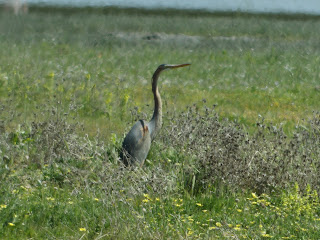My brother David and I spent a few days on the fringes of the Coto Donana flying out on the 12th and returning on the 15th. We stayed in the town of El Rocio in Huelva province which lies on the shore of a large freshwater lake. Sadly after years of negligence on the part of both the national and provincial governments the once great wetland of Donana has effectively dried out, illegal water extraction and drought being the primary causes. Despite this depressing development the lake and the nearby reserve at La Rocina still held decent amounts of both water and birds. With the added bonus of blue skies and sunshine throughout our stay it's fair to say we enjoyed our trip.
 |
| Spoonbill, Purple Heron, Glossy Ibis and White Stork. |
A good selection of herons and other long legged wading birds were on view at both wetlands with Glossy Ibis and Spoonbills in particular showing well. White Storks, as impressive as always, were nesting on many structures along the river and gave some good views, a trio of Purple Herons were less obliging. Commonest Heron was Cattle Egret with over a hundred roosting around the area. Most obvious were perhaps the Flamingos feeding in the lagoon, they positively gleamed in the strong sunshine.
Migration is still in full swing and it brought in a lot of waders pausing on their long journey north. A large flock of over a hundred Ringed Plovers dropped in for an afternoon bringing with them good numbers of both Little Stints and Curlew Sandpipers. Shunning the company of others a Temminck's Stint was one of the trip's highlights, other waders on show included Wood Sandpipers, Ruffs, Dunlins and Black-tailed Godwits. Among the waders were a few resident or breeding species of which the most obvious were the many Black-winged Stilts. A few Avocets were a welcome addition to the trip list but were overshadowed by a flock of over seventy Collared Pratincoles, I've never seen them in anything like these numbers before. Also moving through were a few terns with a Gull-billed and at least eight Whiskered being seen.
Raptor numbers and variety were a little disappointing, there were plenty of Black Kites around but not much of anything else. I did though welcome the chance to see Griffon Vultures for the first time in years even if they were distant. If raptors disappointed then rails did not as first Purple Swamphens and then a Crested Coot were found. The coot which was seen at La Rocina was my first ever and took a little while to confirm, it's ID was clinched by a record shot. Although it frequently disappeared into cover we did get decent scope views eventually though it took some patience! Another new bird was Iberian Chiffchaff, despite frequent visits to Spain I hadn't managed to catch up with them before. My brother David did not miss out on new birds either as a party of Common Waxbills were a welcome addition to his WP list.
Other bird highlights to mention included Iberian Magpies as a good number were seen at La Rocina. These ever active crows are a pain to photograph but entertaining to watch, these were my first for over ten years. Rivalling the magpies for interest if not numbers was a Lesser Spotted Woodpecker which was my first Spanish sighting. I don't want to keep listing birds so will close by saying that this area is well worth a visit if you want to catch up with some scarce or rare species. Not too much of other wildlife interest was on view though an influx of Vagrant Emperors meant that I was able to add to my single sighting from 2019. Butterflies were few in number but a very fresh looking Two-tailed Pasha taking a rest from the sun provided some great views. All in all a very good trip, two lifers and eighty plus species in a two day spell will be hard to beat.
















No comments:
Post a Comment